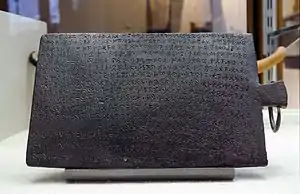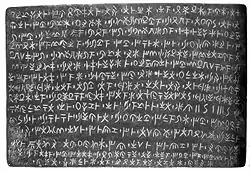Idalion Tablet
The Idalion Tablet is a 5th-century BCE bronze tablet from Idalium (Greek: Ιδάλιον), Cyprus. It is kept in the Cabinet des médailles, Paris. It was found in 1850 in Dali, Cyprus, and was purchased by Honoré Théodoric d'Albert de Luynes, who donated it to the Bibliothèque Nationale de France in 1862.[1]

It is of exceptional importance for the history of the Cypriot kingdoms. It is engraved on both sides with a long inscription recording a contract entered into by 'the king and the city' and gives a reward to a family of physicians who provided free health services for the casualties when the city was besieged by the Persians and the Kitionites in 478-470 BC. It tells us about the political system and socio-economic conditions during the war. The joint decision by the king and citizens shows the democratic nature of the city, similar to Greek models. It also tells of the most ancient social welfare system known.
It was kept in the ancient official depository of the temple of Athena on the western acropolis of Idalion where it was discovered in 1850 by a farmer from the village of Dali.
The script of the tablet is in the Cypriot syllabary and the inscription itself is in Greek.[2] However, the script was not deciphered until after the 1870 discovery of the Idalion bilingual.
Cypriot syllabary and Greek

Approximately two lines of the text state as follows:
"...they ordered Onasilon the (son) of Onasikupron the physician and the brothers to heal the men those in the battle wounded without fee."[3] The text is read from right to left.
Below is the Greek translation, associated with the Cypriot characters; (line 3 starts with Cypriot character ro (looking like 'loop of rope, open end down', loop, top half of character), line 4 starts with Cypriot ma, a distinctive Cypriot syllabic character, (an X, with a small upside-down-karat, topping, and between the X):
- "...anógon-(a-no-ko-ne) Onasilon-(o-na-si-lo-ne) ton Onasikuprón-(to-no-na-si-ku-po-(Line 3)ro-ne) ton iatéran-(to-ni-ja-te-ra-ne) kas-(ka-se) tos-(to-se) kasignétos-(ka-si-ke-ne-to-se) iasthai-(i-ja-sa-ta-i) tos-(to-se) (=men)a(n)thrópos-(a-to-ro-po-se) tos-(to-se) i(n) tái-(i-ta-i) makhái-(ma-ka-i) ikmamenos-(i-ki-(Line 4)ma-me-no-se) aneu-(a-ne-u) misthón-(mi-si-to-ne)..."[3]
References
Citations
- Patrick Callet et al, An Emblematic Bronze from Cyprus the Idalion Project Euro-Mediterranean Conference, EuroMed 2010: Digital Heritage pp 206-224
- Chadwick 1987, p. 55
- Chadwick 1987, p. 56.
Sources
- Chadwick, John (1987). Linear B and Related Scripts. Reading the Past. London and Berkeley: British Museum and University of California Press. ISBN 0-520-06019-9.CS1 maint: ref=harv (link)